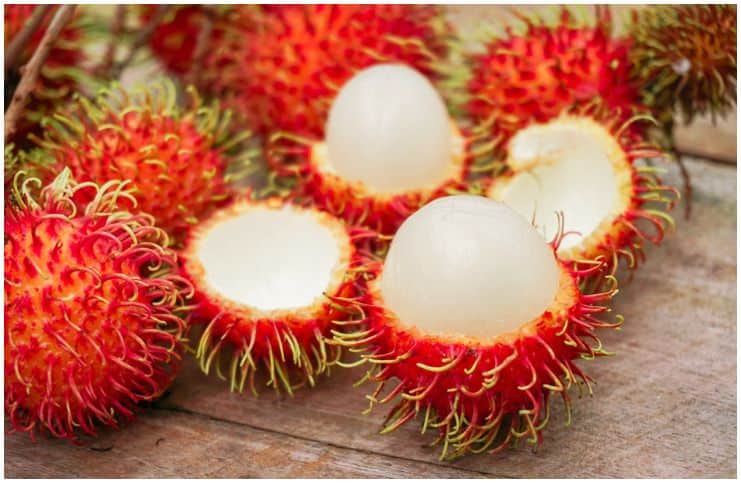Rambutan
The rambutan tree (scientific name – Nephelium lappaceum) thrives in tropical climates, mainly in Asia where these fruits are abundant, and it typically grows up to approximately 80 feet in height. According to data, these trees show that they were cultivated by the Malayan jungle.
It is a fruit that is red in color and small in size. It commonly tastes sweet and is slightly acidic, nevertheless, some are sour and sweet. The seed of this fruit is brown colored and the oil extracted from these seeds may be used in several industries. The skin of the fruit has spiky hair on it.
Nutrition Facts
This fruit is rich in sugar, mostly sucrose and fructose, and is abundant in potassium, vitamin C, iron, and vitamin A (as beta-carotene). Moreover, it has a little calcium, magnesium, copper, manganese, sodium, zinc, niacin, dietary fiber, and protein.
It also has no trans and saturated fats or cholesterol. Plus, this fruit also has a high water content, that lowers thirst levels, hence, preventing dehydration.
Health Benefits
Excellent Source Of Manganese
Manganese is an essential trace mineral for human health. For instance, it helps convert fats and proteins into energy, activate antioxidant enzymes, and support bone and cartilage formation.
This mineral is also involved in the production of fatty acids and aids in the production of sex hormones. Additionally, manganese activates enzymes responsible for the use of thiamin, biotin, thiamin, choline, and vitamin C.
100g of this fruit contains 0,3 mg of manganese which is about 17 percent of the daily recommended intake.
Prevents Iron-Anemia
Iron is a mineral present in hemoglobin, which transports oxygen from the lungs to the different tissues in the body. If you have a deficiency in iron, you may have a decreased immunity, experience fatigue, or iron-deficiency anemia, which is the most common nutritional deficiency in the world. 100g of this fruit contains approximately 0,4 mg of iron.
Anti-Inflammatory Properties
Gallic acid, a potent antioxidant, is found on the skin of this exotic fruit. Gallic acid is effective in eliminating the free radicals from the cells. Additionally, this compound prevents the expression of inflammatory chemicals including histamines and cytokines as well as it has potent anti-inflammatory properties, according to a 2008 study published in the journal “Toxicological Sciences.”
Improves Sperm Count
Vitamin C is a vital antioxidant that boosts the immune system so that it can fight free, harmful radicals. Also, the quantity of vitamin C in this fruit is very important for sperm development, because a lack of vitamin C in the regular diet in males may lead to restricted reproductory functions.
This vitamin also helps the assimilation of non-heme iron in the human body. A 100-gram serving of fresh fruit has approximately 40 mg of vitamin C, which is 66 percent of the daily recommended intake.
Side Effects
There are no scientifically proven side effects.
Lychee
It is a tasty and sweet strawberry-red fruit with an easily peeled skin, which is considered the symbol of romance and love in present-day China.
This fruit is also cultivated in numerous countries around the world, however, the most production is found in China, Southeast Asia, Southern Africa, and India.
Nutrition Facts
These exotic fruits are high in vitamin C, phosphorus, copper, niacin, vitamin B6, folate, magnesium, riboflavin, potassium, and manganese. Furthermore, it is a good source of fiber, protein, as well as polyphenolic compounds and proanthocyanidins.
Health Benefits
Enhances Collagen Production
Vitamin C is a potent anti-oxidant that helps the human body to maintain and form healthy connective tissues, bones and blood vessels. Vitamin C is beneficial in the treatment of iron deficiency anemia and cures and prevents scurvy (characterized by gingivitis, general weakness, and skin hemorrhages).
100g of this fruit has 71,5 mg of vitamin C which is 119 percent of the daily recommended intake.
Weight Loss
Copper is a vital micronutrient necessary by the human body at a level of approximately 1mg each day that must be taken from the diet. Copper is an important part of many essential enzymes, known as cuproenzymes.
This trace mineral also works with another mineral – iron, to create red blood cells. Lastly, it helps the body to have a healthy digestive system.
100g of these fruits have 0,1 mg of copper that is about 7 percent of the daily recommended intake.
Electrolyte Balance
Potassium is the 3rd most abundant mineral in the body. This essential mineral works to maintain a healthy fluid balance between the body fluids and cells.
Moreover, it aids to help regulate the heartbeat, help nerve conduction, and help the muscles contract. It is involved in the metabolism of sugar to glycogen to provide the much-needed energy for daily needs.
100g of this fruit has 171 mg of potassium that is about 5 percent of the daily recommended intake.
Cardiovascular Health
Fiber is material from plant cells that cannot be broken down by enzymes in the digestive tract. A regular diet high in dietary fiber can help reduce LDL and total cholesterol levels, therefore, promoting cardiovascular health by preventing atherosclerosis (also referred as hardening of the arteries).
Dietary fiber also acts like “nature’s broom,” sweeping up all the toxins in the human digestive tract, removing them in the stool.
100g of this amazing fruit has 5 percent of the daily recommended intake of dietary fiber.
Side Effects
There are no scientifically proven side effects.
Rambutan vs Lychee – Which Has A Better Nutritional Profile?
Both fruits are tasty and nutritious, but lychee clearly wins this contest due to its higher content of vitamin C, riboflavin, niacin, copper, and potassium.
Images credit – Shutterstock
READ THIS NEXT: Sunflower Seeds vs Almonds

If fresh ones are not available, how does the canned version compare with the fresh